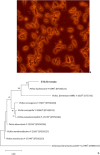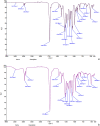Evaluation of polyhydroxyalkanoate (PHA) synthesis by Pichia sp. TSLS24 yeast isolated in Vietnam
- PMID: 36823427
- PMCID: PMC9950484
- DOI: 10.1038/s41598-023-28220-z
Evaluation of polyhydroxyalkanoate (PHA) synthesis by Pichia sp. TSLS24 yeast isolated in Vietnam
Abstract
Following the rising concern on environmental issues caused by conventional fossil-based plastics and depleting crude oil resources, polyhydroxyalkanoates (PHAs) are of great interest by scientists and biodegradable polymer market due to their outstanding properties which include high biodegradability in various conditions and processing flexibility. Many polyhydroxyalkanoate-synthesizing microorganisms, including normal and halophilic bacteria, as well as algae, have been investigated for their performance in polyhydroxyalkanoate production. However, to the best of our knowledge, there is still limited studies on PHAs-producing marine yeast. In the present study, a halophilic yeast strain isolated from Spratly Island in Vietnam were investigated for its potential in polyhydroxyalkanoate biosynthesis by growing the yeast in Zobell marine agar medium (ZMA) containing Nile red dye. The strain was identified by 26S rDNA analysis as Pichia kudriavzevii TSLS24 and registered at Genbank database under code OL757724. The amount of polyhydroxyalkanoates synthesized was quantified by measuring the intracellular materials (predicted as poly(3-hydroxybutyrate) -PHB) by gravimetric method and subsequently confirmed by Fourier transform infrared (FTIR) spectroscopic and nuclear magnetic resonance (NMR) spectroscopic analyses. Under optimal growth conditions of 35 °C and pH 7 with supplementation of glucose and yeast extract at 20 and 10 gL-1, the isolated strain achieved poly(3-hydroxybutyrate) content and concentration of 43.4% and 1.8 gL-1 after 7 days of cultivation. The poly(3-hydroxybutyrate) produced demonstrated excellent biodegradability with degradation rate of 28% after 28 days of incubation in sea water.
© 2023. The Author(s).
Conflict of interest statement
The authors declare no competing interests.
Figures





References
-
- Bugnicourt E, Cinelli P, Lazzeri A, Alvarez V. Polyhydroxyalkanoate (PHA): Review of synthesis, characteristics, processing and potential applications in packaging. eXPRESS Polym. Lett. 2014;8(11):791–808. doi: 10.3144/expresspolymlett.2014.82. - DOI
-
- Sudesh K, Abe H, Doi Y. Synthesis, structure and properties of polyhydroxyalkanoates: Biological polyesters. Prog. Polym. Sci. 2000;25:1503–1555. doi: 10.1016/S0079-6700(00)00035-6. - DOI
-
- Park YL, Bhatia SK, Gurav R, Choi TR, Kim HJ, Song HS, Park JY, Han YH, Lee MS, Park LS, Lee HS, Kim YG, Yang HY. Fructose based hyper production of poly-3-hydroxybutyrate from Halomonas sp. YLGW01 and impact of carbon sources on bacteria morphologies. Inter. J. Biolog. Macromol. 2020;154(1):929–936. doi: 10.1016/j.ijbiomac.2020.03.129. - DOI - PubMed
Publication types
MeSH terms
Substances
LinkOut - more resources
Full Text Sources

